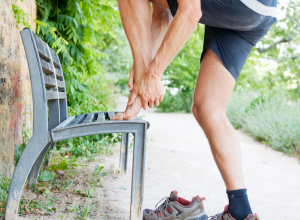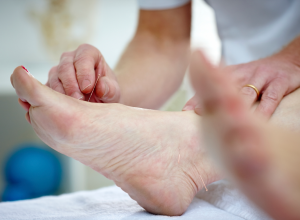
Heel Spur
A heel spur (sometimes called a calcaneal spur or osteophyte) is a small bony calcium deposit that protrudes from the side or underside of the heel (calcaneus bone). Heel spurs can extend forward by as much as half an inch.
Symptoms
More often than not, people with heel spurs don’t have any symptoms. However, the bony protrusions can sometimes irritate the surrounding tissue, thereby causing inflammation that can lead to intermittent or chronic pain in the back and underside of the foot while running, jogging, walking and engaging in other types of physical activity. The pain — usually described as a sharp knife or pin sticking into the bottom of the foot — is generally at its greatest first thing in the morning and slowly dissipates during regular activity throughout the day. Heel spurs are frequently associated with plantar fasciitis, a condition that causes painful inflammation in plantar fascia (the thick band of tissue that runs along the bottom of the foot and connects the heel bone to the toes). Heel spurs are generally invisible to the naked eye and must be detected via X-ray.
Causes
As mentioned above, heels spurs are calcium deposits that build up on the underside of the foot when the bone, muscles or ligaments in the area are exposed to constant stress from things like jogging, wearing poorly fitted shoes and carrying excess body weight.. The formation of the spur usually develops over a period of several months as the body’s form of protection to the heel. As mentioned above, heel spurs are often associated with plantar fasciitis, though experts don’t yet understand why, as noted on sites like MedicineNet and WebMD.
Risk factors for heels spurs include gait abnormalities that lead to pronation issues, running and jogging, excess weight and obesity, diabetes, and poorly fitting shoes that lack arch support. As mentioned above, heel spurs are frequently associated with plantar fasciitis, which is a painful inflammation of the band of tissue (plantar fascia) along the bottom of the foot that connects the calcaneus bone to the toes.
Treatment and Prevention
Treatment options for heel spurs include exercise, orthotics, cortisone injections, anti-inflammatory medications, and physical therapy. A combination of these methods usually helps the condition, with 90 percent or more getting better within a couple of months.
If you have heel pain that persists for several weeks and does not respond to rest, you should visit a health care provider. He or she may recommend stretching exercises to strengthen and repair the plantar fascia, shoe inserts and/or orthotic devices, shoe recommendations and physical therapy. Pain associated with the condition can be treated with over-the-counter medications, but more often than not, orthotics can usually correct the causes of heel spurs and relieve the pain on their own. In rare cases, a corticosteroid injection can be given to reduce inflammation.
Most cases of heel spurs can be treated with non-surgical options, but if conservative treatments fail after a period of six to 12 months, surgery can be considered. According to medical sites like WebMD and MedicineNet, two main techniques include release of the plantar fascia and removal of the spur. However, as both come with risk of complications (including chronic heel pain, difficulty walking, foot cramps or permanent numbness in the area), surgery is usually only offered as a last resort.
Heels spurs can be prevented by wearing comfortable, properly fitted shoes that are appropriate for the type of activity one is engaging in. Proper footwear helps keep one’s pronation correct as well as protects the feet from irritation. Other preventative measures include avoiding high heels, losing excess weight and stretching before engaging in physical activity.
Notice concerning medical entries:
Articles having medical content shall serve exclusively for the purpose of general information. Such articles are not suitable for any (self-) diagnosis and treatment of individual illnesses and medical indications. In particular, they cannot substitute for the examination, advice, or treatment by a licensed physician or pharmacist. No replies to any individual questions shall be effected through the articles.







